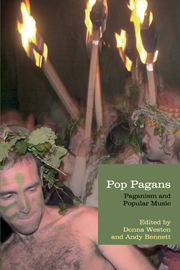Book contents
- Frontmatter
- Contents
- Contributors
- Foreword
- 1 Towards a definition of Pagan music
- Part I Histories
- Part II Genres
- Part III Performance
- 8 Dancing Paganism: music, dance and Pagan identity
- 9 Total solar eclipse festivals, cosmic pilgrims and planetary culture
- 10 Techno-shamanism and the economy of ecstasy as a religious experience
- Part IV Communities
- Bibliography
- Discography and filmography
- Index
8 - Dancing Paganism: music, dance and Pagan identity
from Part III - Performance
- Frontmatter
- Contents
- Contributors
- Foreword
- 1 Towards a definition of Pagan music
- Part I Histories
- Part II Genres
- Part III Performance
- 8 Dancing Paganism: music, dance and Pagan identity
- 9 Total solar eclipse festivals, cosmic pilgrims and planetary culture
- 10 Techno-shamanism and the economy of ecstasy as a religious experience
- Part IV Communities
- Bibliography
- Discography and filmography
- Index
Summary
You are how you move.
(Roth 1997: xxiii)In the video of a Faithless live performance of the song “God is a DJ”, the camera pans out over a mass of dancing humanity and Maxi Jazz sings: “This is my church, this is where I heal my hurts” (Faithless 2010). The argument of this chapter is that, for Pagans in Australia, dancing to the music of Pagan bands creates both a sense of individual transformation (hurts are healed), and a spiritual community (perhaps not a church, but a collective with church-like functions nonetheless). Pike makes the same two points in her comment about Pagan festivals: “Festivals are an arena for self-creation as well as a space for making community” (Pike 2001: 155).
The chapter begins with a short introduction to contemporary Paganism in Australia. Dancing to Pagan music is a central part of contemporary Pagan religious practice. It is a key practice that contributes to personal transformation – one that is valued by many Pagans. The latter half of the chapter argues that dancing is also central to the creation of Pagan community and to the collective experience of the sacred. Pagan identities are hybrid and eclectic in nature; they do not cohere around centrally defined beliefs. Dancing at Pagan rituals – particularly to Pagan music – is a key practice that facilitates the identification of oneself as “Pagan”.
- Type
- Chapter
- Information
- Pop PagansPaganism and Popular Music, pp. 110 - 125Publisher: Acumen PublishingPrint publication year: 2013



